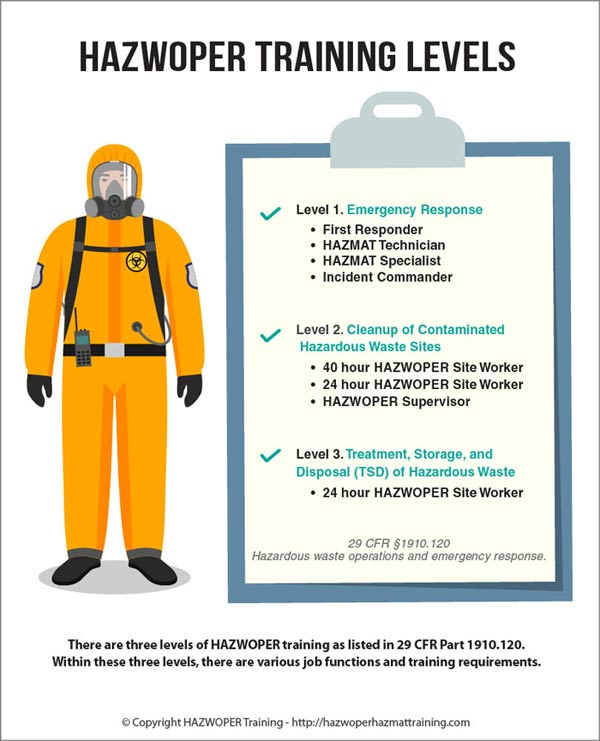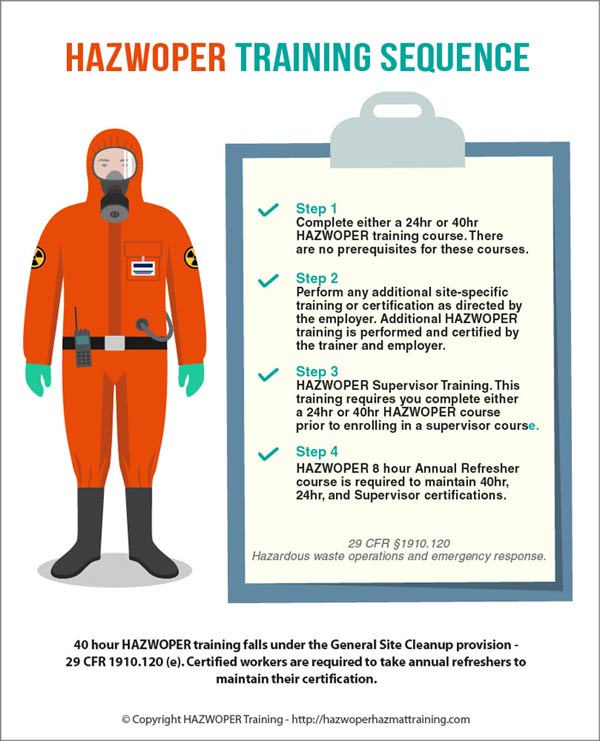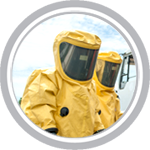Hazmat Training Requirements
- HAZWOPER Training Levels
- HAZWOPER Training Sequence
- RCRA Training Requirements
HAZWOPER Training Levels
There are 3 levels for HAZWOPER training as listed in the OSHA 1910.120 regulations. Within these 3 levels are various job functions and training requirements. Each of these levels offer HAZWOPER certification for the different job functions.
Level 1. Emergency Response
Emergency Response - 29 CFR 1910.120 (q);
Emergency response program to hazardous substance releases. This paragraph covers employers whose employees are engaged in emergency response no matter where it occurs except that it does not cover employees engaged in operations specified in paragraphs (a)(1)(i) through (a)(1)(iv) of this section. Those emergency response organizations who have developed and implemented programs equivalent to this paragraph for handling releases of hazardous substances pursuant to section 303 of the Superfund Amendments and Reauthorization Act of 1986 (Emergency Planning and Community Right-to-Know Act of 1986, 42 U.S.C. 11003) shall be deemed to have met the requirements of this paragraph.
- HAZMAT Technician
- HAZMAT Specialist
- Incident Commander
Level 2. Cleanup of Contaminated Hazardous Waste Sites
General Site Cleanup - 29 CFR 1910.120 (e);
All employees working on site (such as but not limited to equipment operators, general laborers and others) exposed to hazardous substances, health hazards, or safety hazards and their supervisors and management responsible for the site shall receive training meeting the requirements of this paragraph before they are permitted to engage in hazardous waste operations that could expose them to hazardous substances, safety, or health hazards, and they shall receive review training as specified in this paragraph.
- 40 hour HAZWOPER Site Worker
- 24 hour HAZWOPER Site Worker
- HAZWOPER Supervisor
Level 3. Treatment, Storage, and Disposal (TSD) of Hazardous Waste
Resource Conservation Recovery Act (RCRA) Treatment, Storage and Disposal Facilities (TSDF) - 29 CFR 1910.120 (p).
Certain Operations Conducted Under the Resource Conservation and Recovery Act of 1976 (RCRA). Employers conducting operations at treatment, storage and disposal (TSD) facilities specified in paragraph (a)(1)(iv) of this section shall provide and implement the programs specified in this paragraph. See the "Notes and Exceptions" to paragraph (a)(2)(iii) of this section for employers not covered.
- 24 hour HAZWOPER Site Worker

HAZWOPER Training Sequence
- Step 1. Complete either the 24 hour or 40 hour HAZWOPER training course. There are no prerequisites for these courses.
- Step 2. Perform any additional site-specific training or certification as directed by employer. Additional HAZWOPER training is performed and certified by the trainer and employer.
- Step 3. HAZWOPER Supervisor Training. This training requires you complete either a 24 hour or 40 hour HAZWOPER course prior to enrolling in a supervisor course.
- Step 4. HAZWOPER 8 hour Annual Refresher course is required to maintain 40 hour, 24 hour, and Supervisor certifications.
RCRA Training Requirements
The EPA requires RCRA training for “personnel” [40 CFR 260.10 - Definitions] or "all persons who work at, or oversee the operations of, a hazardous waste facility, and whose actions or failure to act may result in noncompliance" - must complete RCRA training within 6 months of initial hire - and take an 8 hour refresher training course annually [40 CFR 265.16(b) and (c)].
- 40 CFR §265.16 Personnel training.
- (a) (1) Facility personnel must successfully complete a program ... that teaches them to perform their duties in a way that ensures the facility's compliance with the requirements of this part.
- (b) Facility personnel must successfully complete the program required in paragraph (a) of this section within ... six months after the date of their employment or assignment to a facility, or to a new position at a facility, whichever is later. Employees hired after the effective date of these regulations must not work in unsupervised positions until they have completed the training requirements of paragraph (a) of this section.
- (c) Facility personnel must take part in an annual review of the initial training required in paragraph (a) of this section.
Employers should train all personnel that handle hazardous waste so they are able to properly recognize and manage hazardous wastes in order to identify situations that could cause releases and react quickly to prevent or stop spills.

Very Small Quantity Generators
- Hazardous Waste Generated - Quantity Limits: ≤ 100 kg/month, and ≤ 1 kg/month of acute hazardous waste, and ≤ 100 kg/month of acute spill residue or soil.
- RCRA Training: Training not mandatory - but recommended so employees can recognize and properly manage hazardous wastes and prevent spills.
- 40 CFR 260.14
Small Quantity Generators
- Hazardous Waste Generated - Quantity Limits: >100 kg/month and <1,000 kg/month
- RCRA Training: Basic RCRA training required.
- 40 CFR 262.16 (b)(9)(iii)
- (iii) The small quantity generator must ensure that all employees are thoroughly familiar with proper waste handling and emergency procedures, relevant to their responsibilities during normal facility operations and emergencies.
Large Quantity Generators
- Hazardous Waste Generated - Quantity Limits ≥1,000 kg/month, or >1 kg/month of acute hazardous waste, or >100 kg/month of acute spill residue or soil
- RCRA Training: Full RCRA training Required
- 40 CFR 262.17(a)(7)
- (7)Personnel training.
- (i)(A) Facility personnel must successfully complete a program of classroom instruction, online training (e.g., computer-based or electronic), or on-the-job training that teaches them to perform their duties in a way that ensures compliance with this part.
- (C) At a minimum, the training program must be designed to ensure that facility personnel are able to respond effectively to emergencies by familiarizing them with emergency procedures, emergency equipment, and emergency systems, including where applicable:
- (1) Procedures for using, inspecting, repairing, and replacing facility emergency and monitoring equipment;
- (2) Key parameters for automatic waste feed cut-off systems;
- (3) Communications or alarm systems;
- (4) Response to fires or explosions;
- (5) Response to ground-water contamination incidents; and
- (6) Shutdown of operations.
- (iii)Facility personnel must take part in an annual review of the initial training required in paragraph (a)(7)(i) of this section.



